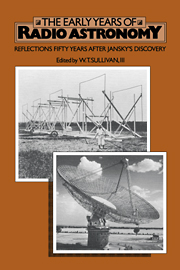Book contents
- Frontmatter
- Contents
- Preface
- THE EARLIEST YEARS
- AUSTRALIA
- ENGLAND
- THE REST OF THE WORLD
- BROADER REFLECTIONS
- Styles of research in three radio astronomy groups
- The influence of radio astronomy on cosmology
- Nanohertz astronomy
- Radio astronomy and the nature of science
- Biographical notes on contributors
- Name index
- Subject index
Styles of research in three radio astronomy groups
Published online by Cambridge University Press: 05 March 2010
- Frontmatter
- Contents
- Preface
- THE EARLIEST YEARS
- AUSTRALIA
- ENGLAND
- THE REST OF THE WORLD
- BROADER REFLECTIONS
- Styles of research in three radio astronomy groups
- The influence of radio astronomy on cosmology
- Nanohertz astronomy
- Radio astronomy and the nature of science
- Biographical notes on contributors
- Name index
- Subject index
Summary
The development of the three pioneer radio astronomy groups at Sydney, Jodrell Bank and Cambridge offers historians and sociologists of science an unusual opportunity to make a comparative study of concurrent ‘research schools’. What emerges is an intriguing story of the interrelationship of technical strategy and commitments, social structure, and scientific style.
The main advantage in studying a research school (as opposed to, say, a more loosely defined ‘specialty network’ or ‘invisible college’) is that any school is an unproblematic group – it consists of specifiable people, working together. The three radio astronomy groups also shared a number of other common factors, which simplifies any comparative analysis. To begin with, they all embarked, essentially from scratch, into a virgin area of research in which they shared the same initial clues – namely, the original observations of Jansky, Reber and Hey – solar and galactic radio emissions; the existence of discrete sources, or ‘radio stars’; and radar reflections from meteors. What is more, since all the researchers had been engaged in wartime radar development, they shared the same technical resources and insights, and cannibalised or adapted the same equipment. Many of them had been active colleagues. They understood the same patois of electromagnetic theory — especially as it related to aerial design — and they all had access to, and familiarity with, at least some elements of the crucial ‘Fourier transform’ theory. The two British groups were both sections of prestigious university Physics Departments, and both Martin Ryle (at Cambridge) and Bernard Lovell (at Jodrell Bank) were given effectively carte blanche support by eminent superiors — J.A. Ratcliffe at Cambridge, Patrick Blackett at Manchester.
- Type
- Chapter
- Information
- The Early Years of Radio AstronomyReflections Fifty Years after Jansky's Discovery, pp. 351 - 364Publisher: Cambridge University PressPrint publication year: 1984
- 1
- Cited by



